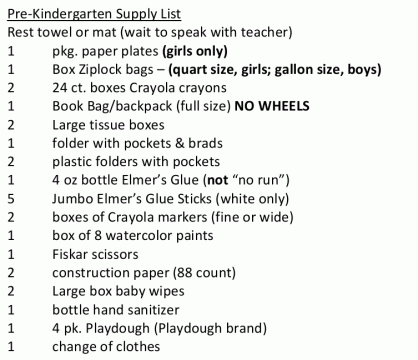I’m writing this one based on a tip from a concerned friend of a parent of a Copperas Cove ISD elementary school student, and based on some replies I got on Twitter when I asked about this. I’m not mentioning the specific school for privacy reasons, and because it really doesn’t matter (I looked at the school supply lists for all of the district’s schools and they are all like this).
At issue here is the practice of mentioning brand names on school supplies. There are tons of examples like this, but as a random example here’s the Martin Walker elementary list for pre-kindergarten (this is a screenshot of my PDF reader edited only by cropping; I have made no attempt to correct misspellings of brand names):

I count at least four brand name mentions: “Ziplock” bags (the brand name is actually spelled Ziploc without the “k”), Crayola crayons, Elmer’s glue, and “Playdough” (the actual brand name is Play-Doh). (Don’t worry, I’ll get to the spelling issue in a moment; it’s tangential to the core reason for my post.)
Now, the rationale one of my Twitter followers gave in the specific case of crayons is that the colors change between Crayola and, say, Rose Art or a store brand. I would assume this applies to colored markers or other colored art supplies as well. As true as this may be, while I’m a fan of good marketing and branding, I find this a bit disturbing in two, possibly three different ways.
The first is that not all parents can necessarily afford to pay a premium for name brand products. I will admit at one point I was one of those kids growing up: I was called among other derisive names “the K-Mart kid” (this was before Wal-Mart’s dominance, in fact, this was when we still had K-Mart in Houston, years before K-Mart bet the farm on Martha Stewart prior to her legal difficulties in 2004). However, there is an amusing anecdote here: with some help we (my mom, grandmother, and I) did find a pair of Nike Wimbledon tennis shoes at a discount clothing outlet (Weiner’s) that all the kids thought we bought at Foot Locker for $70. (To my former classmates out there reading this: Fooled ya!) Anyway, kidding and humorous anecdotes aside, I think it’s a bit over-the-top for schools to insist upon brand names from parents pinching pennies for school supplies.
The second, which may be somewhat related to the first, is that we already have enough jealousy among school kids about clothing, shoes, and other fashion-related items such as backpacks. This adds to the “uneven playing field” when little Johnny or Jane are making do with Rose Art crayons while the better-off kids are showing off their set of Crayola. As much as the schools would like to make it so, asking for brand name items does not magically put money in the pockets of parents who have to buy them. It means maybe more of the kids will show up with, in this case, Crayola crayons, but the poorer kids will stand out that much more as a result.
The third, kids are impressionable. There are strict limits on advertising during children’s television programs for a reason. Now this is where my admiration of branding and marketing is really put to the test. I’m not opposed to marketing towards kids, but I think the first years of elementary school are a bit too young to surround kids with the insistence on name-brand items. There will be plenty of time for kids to learn consumerism and the nuances of branding and advertising from a consumer point of view. I’m pretty sure they won’t get it in kindergarten or first grade.
Now, the least the school districts can do, if they must put brand names in the school supply shopping lists, is spell them correctly. This is first and foremost, respect for the companies and their trademarks, and second, it’s also an example for the kids that will get to see these lists as well (they see them more often than school administrators think). Usually the school supplies change little from year to year, so it should be a simple matter of keeping a list of the name brands and how to spell them to refer to when late July/early August rolls around (or whenever the list comes out). Really, what does it say about our public school system when the school supply lists are published with mistakes such as these? What kind of confidence does it give the kids that know better and may even say “look mommy, they misspelled Ziploc” when they find it?

